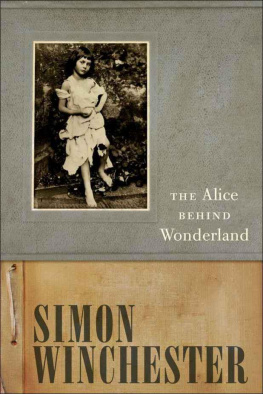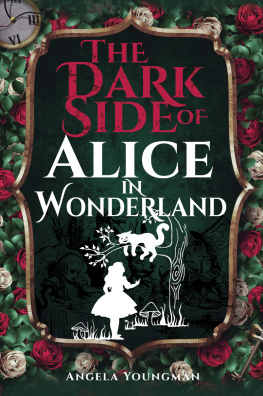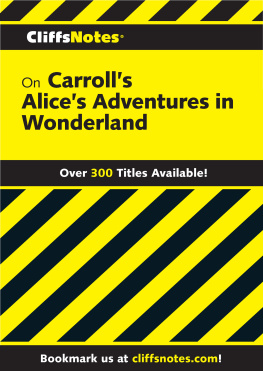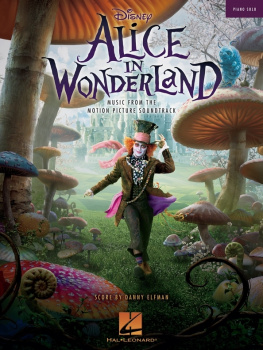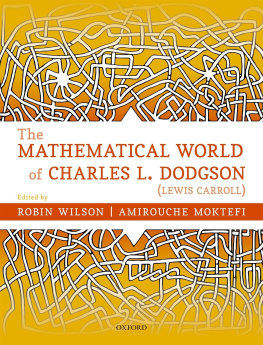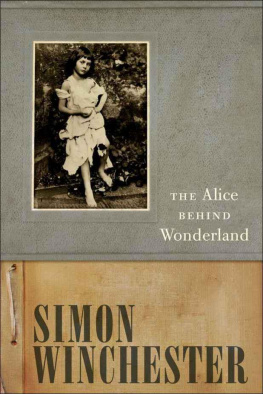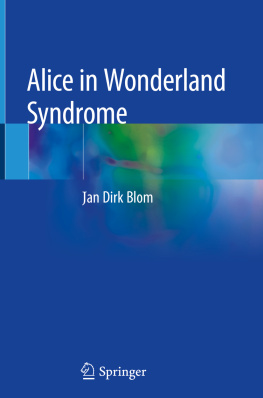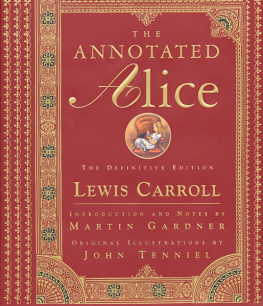The A LICE Behind
W ONDERLAND
ALSO BY SIMON WINCHESTER
Atlantic: The Biography of an Ocean
A Crack at the Edge of the World
The Meaning of Everything
Krakatoa
The Map that Changed the World
The Fracture Zone
The Professor and the Madman
The River at the Center of the World
Small World
Hong Kong: Here Be Dragons
Pacific Nightmare
Pacific Rising
Korea: A Walk Through the Land of Miracles
Outposts
Prison Diary: Argentina
Stones of Empire
Their Noble Lordships
American Heartbeat
In Holy Terror
The Man Who Loved China

The A LICE Behind
W ONDERLAND

SIMON
WINCHESTER


Oxford University Press, Inc., publishes works that further
Oxford Universitys objective of excellence
in research, scholarship, and education.
Oxford New York
Auckland Cape Town Dar es Salaam Hong Kong Karachi
Kuala Lumpur Madrid Melbourne Mexico City Nairobi
New Delhi Shanghai Taipei Toronto
With offices in
Argentina Austria Brazil Chile Czech Republic France Greece
Guatemala Hungary Italy Japan Poland Portugal Singapore
South Korea Switzerland Thailand Turkey Ukraine Vietnam
Copyright 2011 by Simon Winchester
Published by Oxford University Press, Inc.
198 Madison Avenue, New York, NY 10016
www.oup.com
Oxford is a registered trademark of Oxford University Press
All rights reserved. No part of this publication may be reproduced,
stored in a retrieval system, or transmitted, in any form or by any means,
electronic, mechanical, photocopying, recording, or otherwise,
without the prior permission of Oxford University Press.
Library of Congress Cataloging-in-Publication Data
Winchester, Simon.
The Alice behind wonderland / by Simon Winchester.
p. cm.
ISBN 978-0-19-539619-5
1. Carroll, Lewis, 18321898. Alices adventures in Wonderland.
2. Carroll, Lewis, 18321898.Photograph collections.
3. Great BritainSocial life and customs19th century
4. Hargreaves, Alice Pleasance Liddell, 18521934.
5. Fantasy fiction, EnglishHistory and criticism.
6. Childrens stories, EnglishHistory and criticism.
7. Alice (Fictitious character: Carroll). I. Title.
PR4611.A73W56 2011
823.8dc22 2010053503
Photograph of Alice Liddell courtesy of Morris L. Parrish Collection,
Department of Rare Books and Special Collections, Princeton University Library
1 3 5 7 9 8 6 4 2
Printed in the United States of America
on acid-free paper
FOR CYBELE
CONTENTS

Chapter One
THE PHOTOGRAPH IN QUESTION
Chapter Two
THE PHOTOGRAPHER-TO-BE
Chapter Three
MATTERS ARISING
Chapter Four
THE RUDE MECHANICALS
Chapter Five
THE FIRST MAKINGS OF ART
Chapter Six
A PORTRAIT MOST PERFECT AND CHASTE
Chapter Seven
AND THEN THE GIRL BECAME A LADY
The A LICE Behind
W ONDERLAND
Chapter One
THE PHOTOGRAPH IN QUESTION
ON THE MAIN FLOOR OF THE FIRESTONE LIBRARY, THE COZILY magnificent and prematurely ancient (it was built in 1948) Gothic centerpiece of the Princeton University campus, there is what appears to be the private library of an English gentlemans country house, carefully set back and hidden away to keep it from the general bustle of readers.
Beyond its collection of leather-bound books, this room-within-a-room is notable for its deep and corduroy-ribbed reading chairs, stained glass, richly polished paneling, lamps, and portraits. Perhaps most impressive of all to those of romantic disposition is its baronial fireplacein which, however, no fire is ever permitted to be lit because of its being sited within a great and very flammable academic library.
The room is more than just a faithful reproduction of the libraryit is the library, reconstructed panel by panel, carpet by carpet, book by bookthe library of a mansion, Dormy House, built some thirty miles away in the tiny New Jersey hamlet of Pine Valley, a swanky Philadelphia suburb, really. The house was owned by a wealthy financier, Morris Longstreth Parrish, a Princeton alumnus whose passions were many, though few so great as that for collecting Victorian books.
Parrish & Company was a prominent Philadelphia stockbroking firm, a member of the exchange from the end of the nineteenth century, and owned by a colonial-era family long prominent in Main Line society. Well traveled and well rounded, Morris Parrish never graduated from Princeton. His wealth and other interests much distracted him from his studies. But as a young man he developed a keen interest in books. He read everything he could, furiously, though he much preferred the Victorian and Edwardian classics to later twentieth-century novels, which he generally disdained, though he prized them as objects later. Nonetheless, reading was all. He abhorred dust jackets, slip cases, penciled prices marked inside the coverand unread books. A collector who has unopened books is to me an enigma, he once wrote. He cannot, of course, read them; and no-one can deny that if a book cannot be read, it loses its purpose of existence.
He started collecting in the early 1890s, his initial aim the perfection of his parents collection of Charles Dickens novels, which his father had bought edition by edition as they were published. Morris made an early and ill-advised decision to rebind some of these volumes for his father in glossy red leather, learning betimes that the smartest collectors strived not to prettify their books, but to maintain them in a state as close as possible to their original condition. From then on, a steely determination settled on Parrish, and with little care for expense he set about ensuring that every book he acquired was in near-original condition. Dealers soon recognized what he wanted (and what he could afford): the term in Parrish condition is still employed in the antiquarian book trade to denote books of such quality as to represent the apotheosis of the collectors art.
It was during the Great War that Parrishs collecting zeal and acumen came to be widely recognizedand before long, dealers around the world were helping him complete full-spectrum runs of all the authors he admired. From the Bronts to Robert Louis Stevenson, from Sir James Barrie to Charlotte Yonge, he collected everythingevery book, every edition, every pamphlet, playbill, poster, binding, variant and foreign-language version ever madeso he could rightly claim to have the worlds best and most comprehensive collection of English Victorian fiction.
By the time he died in 1944, Parrishs formal Victorian library amounted to approximately sixty-five hundred volumes, representing the careers-in-full of the authors he most favoredThackeray, Carlyle, Trollope, Wilkie Collins, Dickens, Bulwer-Lytton, and Froude among themand most comprehensively, almost the entire oeuvre of the Christ Church, Oxford, mathematics lecturer Charles Lutwidge Dodgson, now more familiarly known as Lewis Carroll. (The first manuscript of
Next page
